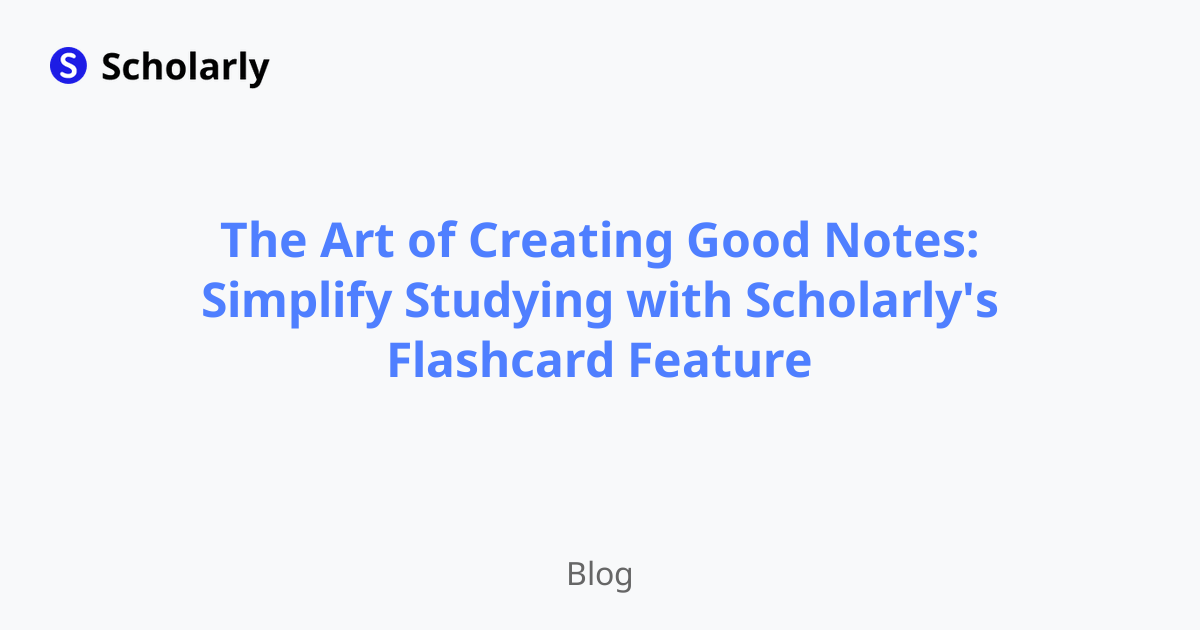The Art of Creating Good Notes: Simplify Studying with Scholarly's Flashcard Feature
Learn the best practices for creating good notes and how Scholarly's flashcard feature can revolutionize your studying experience.

As students, one of the most valuable skills we can develop is the ability to take effective notes. Good notes serve as a foundation for understanding and retaining information, making studying a more efficient and fruitful process. Fortunately, with the advent of technology, note-taking has become even more powerful and accessible. In this article, we'll explore the art of creating good notes and how Scholarly, a student-oriented platform, can revolutionize your note-taking experience by automatically converting your notes into flashcards for seamless studying.
The Power of Good Notes
Taking good notes is an art that can significantly enhance our learning experience. It involves capturing key concepts, organizing information, and summarizing complex ideas in a concise and understandable format. Here are a few benefits of creating good notes:
1. Improved Comprehension
By actively engaging with the material and distilling it into your own words, you enhance your understanding of the subject matter. The process of note-taking encourages critical thinking and helps you identify important points, connections, and patterns.
2. Effective Review
Well-organized notes act as a roadmap for review sessions. They provide a comprehensive overview of the topic, making it easier to revise and reinforce your understanding. Rather than sifting through extensive textbooks or lecture slides, you can quickly navigate through your notes to focus on the most relevant information.
3. Retention and Recall
When you write down information, you reinforce your memory pathways, making it easier to recall the material later. Good notes serve as a reliable reference point, aiding in knowledge retention and ensuring you can recall important details when needed.
Introducing Scholarly's Flashcard Feature
Scholarly is an innovative platform designed by students for students. It offers a range of features to streamline your note-taking process and optimize your studying efforts. One standout feature is the ability to convert your notes into flashcards seamlessly, thanks to the platform's integration of AI technology.
Easy Image Upload
With Scholarly, uploading images or PDFs is a breeze. Simply drag and drop the image onto the page or use the convenient shortcut "CTRL + Z" to instantly add visual content to your notes. This functionality makes it effortless to incorporate diagrams, charts, and other visual aids into your study materials.
Organize with Pages
Scholarly's pages function similarly to the popular platform Notion. They provide a flexible canvas for organizing your notes, flashcards, and images. You can create separate pages for different subjects, lectures, or chapters, allowing for clear and structured note-taking.
Automated Flashcard Creation
The real game-changer comes with Scholarly's AI-powered flashcard feature. Once you've uploaded an image or PDF, hover over the content and click the three-line symbol on the top right corner. A dropdown menu will appear, offering various options. Select "Create Flashcards," and Scholarly's AI, powered by ChatGPT, will work its magic.
Customize and Review
Scholarly understands that personalization is key to effective learning. Once the flashcards are generated, you have the ability to edit them using the pencil icon within the flashcard component. Tailor the content, add additional information, or rearrange the flashcards to suit your learning preferences. This level of customization ensures that the flashcards align with your study goals and reinforce the concepts that are most challenging for you.
Seamless Studying Experience
With your flashcards ready, you can dive into focused study sessions. Scholarly provides a user-friendly interface for reviewing your flashcards. Whether you prefer a question-and-answer format or multiple
Try Our Popular AI Study Tools
Transform your study materials into interactive learning experiences with our most popular AI-powered tools:
PDF to Flashcards
Convert lecture notes and textbooks into study flashcards instantly
Text to Flashcards
Turn any text or notes into comprehensive flashcard sets
Image to Flashcards
Convert diagrams and handwritten notes into digital flashcards
YouTube to Flashcards
Generate flashcards from educational video content




